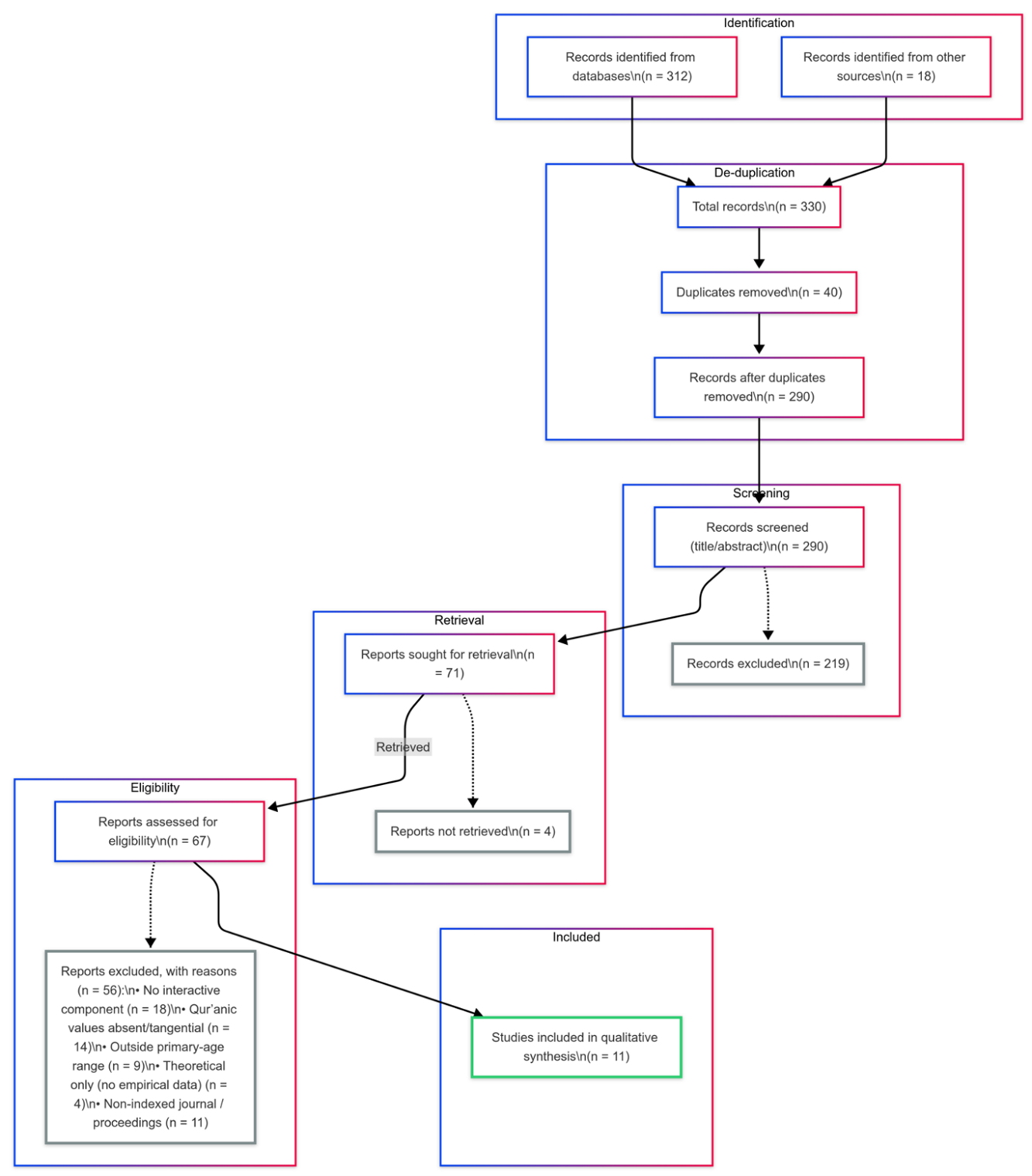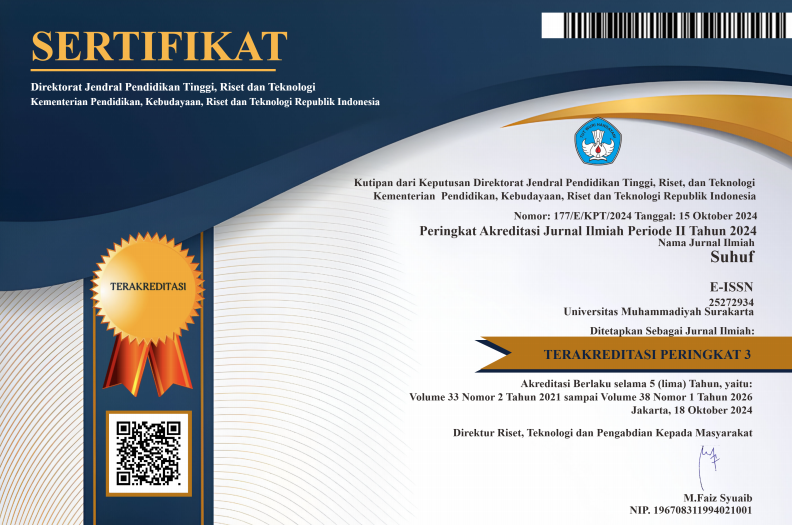An Interactive Qur’anic Values-Based Affective-Learning Approach to Mitigating School Bullying
DOI:
https://doi.org/10.23917/suhuf.v37i1.10637Keywords:
Qurʾānic pedagogy, Interactive learning, Primary education, Islamic values, School BullyingAbstract
Persistent peer bullying in Indonesian primary schools warranted culturally attuned solutions; consequently, a systematic review was conducted to evaluate how interactive programmes embedding Qurʾānic values mitigated bullying. Guided by a pre-registered PRISMA-2020 protocol, seven databases (Scopus, Web of Science, Frontiers, Taylor & Francis, MDPI, Springer, and Google Scholar) were searched for studies published between 2019 and 2025, yielding 330 records, of which 11 empirical studies met the eligibility criteria. The evidence converged into three intervention archetypes digital Qurʾānic storytelling, prophetic-narrative role-play/project learning, and Qurʾān-infused school-climate initiatives that collectively reduced bullying incidents by 30–57 % over 4–12 weeks and increased pupil empathy (Cohen’s d = 0.42–0.88). Although methodological heterogeneity prevailed, all studies reported improvements in peer relations and school climate, suggesting that affective learning grounded in the Qurʾān’s principles of raḥmah, ʿadl, and ukhuwwah fostered prosocial behaviour; however, the paucity of cluster-randomised controlled trials and short follow-ups constrained causal inference. The review concluded that a Qurʾānic pedagogical framework constitutes a culturally congruent complement to secular anti-bullying models, provided that future research incorporates rigorous longitudinal designs. National policy-makers and teacher-education programmes are therefore encouraged to integrate Qurʾānic affective-learning components into anti-bullying guidelines to enhance cultural relevance and long-term sustainability.
Downloads
References
[1] WHO, UNESCO, and UNICEF, “How School Systems Can Improve Health and Well-Being. Topic Brief: mental health,” 2023. [Online]. Available: https://books.google.co.id/books?hl=en&lr=&id=zaq9EAAAQBAJ&oi=fnd&pg=PA5&dq=WHO,+UNESCO,+and+UNICEF,+“How+School+Systems+Can+Improve+Health+and+Well-Being.+Topic+Brief:+mental+health,”+2023.+%5BOnline%5D.+Available:+https://www.who.int/health-topics/health-promotion&ots=GUTiXS2cY3&sig=PLYk2HHdyTUPGW3u0Igdd4t2Ef0&redir_esc=y#v=onepage&q&f=false
[2] S. Johansson, E. Myrberg, and A. Toropova, “School bullying: Prevalence and variation in and between school systems in TIMSS 2015,” Stud. Educ. Eval., vol. 74, p. 101178, 2022, doi: https://doi.org/10.1016/j.stueduc.2022.101178.
[3] T. Menteri Pendidikan, Kebudayaan, Riset, Peraturan Menteri Pendidikan, Kebudayaan, Riset, Dan Teknologi Republik Indonesia Nomor 46 Tahun 2023 Tentang Pencegahan Dan Penanganan Kekerasan Di Lingkungan Satuan Pendidikan. 2023, pp. 1–36. [Online]. Available: https://peraturan.bpk.go.id/Details/224238/permendikbudriset-no-16-tahun-2022
[4] T. Noboru et al., “School‐based education to prevent bullying in high schools in Indonesia,” Pediatr. Int., vol. 63, no. 4, pp. 459–468, 2021, doi: https://doi.org/10.1111/ped.14475.
[5] Raihan, Tasrif, and I. Waluyati, “Bullying di Sekolah dan Dampaknya pada Perilaku Siswa Di Sekolah Dasar [The Impact of School Bullying on the Behavior of Elementary School Students],” J-PAL J. Pendidikan, Budaya, dan Literasi, vol. 1, no. 1, pp. 56–67, (in Indonesia), 2024, doi: https://doi.org/10.71260/jpal.v1i1.10.
[6] L. Arseneault, “Annual research review: the persistent and pervasive impact of being bullied in childhood and adolescence: implications for policy and practice,” J. child Psychol. psychiatry, vol. 59, no. 4, pp. 405–421, 2018, doi: https://doi.org/10.1111/jcpp.12841.
[7] M. M. Hasan et al., “Pathways linking bullying victimisation and suicidal behaviours among adolescents,” Psychiatry Res., vol. 302, p. 113992, 2021, doi: https://doi.org/10.1016/j.psychres.2021.113992.
[8] A. Schleicher, PISA 2018: Insight and Interpretations. Paris: OECD Publishing, 2018.
[9] U. N. E. S. and C. Organization, Behind the numbers: ending school violence and bullying. Paris, France: the United Nations Educational, Scientific and Cultural Organization, 2019. doi: https://doi.org/10.54675/trvr4270.
[10] A. N. ‘Izi, F. N. Anggraini, R. Regita, and Rabi’atul’adawiyah, “Development of the Turnitin System in Improving Plagiarism Detection for Islamic Religious Education Studies,” SUHUF Int. J. Islam. Stud. J., vol. 36, no. 2, pp. 216–226, 2024, doi: https://doi.org/10.23917/suhuf.v36i2.6275.
[11] Mukowim, M. N. R. Maksum, M. Z. Azani, and M. Ali, “Prevention of Verbal Bullying Through Education on Ethics Toward Fault,” in ICIMS 2023, Atlantis Press SARL, 2024, pp. 625–643. doi: https://doi.org/10.2991/978-2-38476-102-9_55.
[12] W. P. Sari, M. Putriana, A. D. Martha, M. R. Firdaus, and N. S. Haura, “Anti-Bullying Learning Videos As An Educational Communication Strategy In Islamic Boarding Schools Al Bunyan,” in Proceedings of the 8th International Conference on Education Innovation (ICEI 2024), Springer Nature, 2025, p. 440. [Online]. Available: https://books.google.co.id/books?hl=en&lr=&id=KNJSEQAAQBAJ&oi=fnd&pg=PA440&dq=W.+P.+Sari,+M.+Putriana,+A.+D.+Martha,+M.+R.+Firdaus,+and+N.+S.+Haura,+Anti-Bullying+Learning+Videos+As+An+Educational+Communication+Strategy+In+Islamic+Boarding+Schools+Al+Bunyan,+no.+Icei+2024.+Atlantis+Press+SARL,+2025.+doi:+10.2991/978-2-38476-360-3.&ots=7kLYnJi_N-&sig=DGzgLQU6X2L9kaL5hcL8yEZZBVg&redir_esc=y#v=onepage&q&f=false
[13] N. Rofiqoh and A. M. Abitolkha, “Bullying in the Perspective of the Quran,” Edunesia J. Ilm. Pendidik., vol. 6, no. 1, pp. 222–237, 2025, doi: https://doi.org/10.51276/edu.v6i1.1062.
[14] D. Kuswandi, A. Rohman, and G. A. Muttaqien, “The Quran Manuscripts in Nusantara : A Historical Review,” SUHUF Int. J. Islam. Stud. J., vol. 36, no. 2, pp. 227–235, 2024, doi: https://doi.org/10.23917/suhuf.v36i2.6513.
[15] Z. Y. Han, Z. Y. Ye, and B. L. Zhong, “School bullying and mental health among adolescents: a narrative review,” Transl. Pediatr., vol. 14, no. 3, pp. 463–472, 2025, doi: https://doi.org/10.21037/tp-2024-512.
[16] WHO and UNICEF, “UNICEF and WHO joint programme on mental health and psychosocial well-being and development of children and adolescents,” Switzerland, 2022. [Online]. Available: https://pesquisa.bvsalud.org/portal/resource/pt/who-363339
[17] Rifah, M. Jailani, and M. Huda, “Artificial Intelligence ( AI ): An Opportunity and Challenge for Achieving Success in Islamic Education in the Era of Digital Transformation,” SUHUF Int. J. Islam. Stud. J., vol. 36, no. 2, pp. 200–215, 2024, doi: https://doi.org/10.23917/suhuf.v36i2.6273.
[18] J. R. Landis and G. G. Koch, “The measurement of observer agreement for categorical data,” Biometrics, vol. 33, no. 1, pp. 159–174, 1977, doi: https://doi.org/10.2307/2529310.
[19] W. Ningsih, “The Role of Islamic Religion Teachers in Preventing Bullying in Primary Schools,” Darussalam J. Psychol. Educ., vol. 2, no. 2, pp. 27–38, 2023, doi: https://doi.org/10.55849/djpe.v2i2.40.
[20] N. M. Nor, S. M. S. Abdullah, and S. N. H. A. Rahman, “Islamic Counseling Approach by Abdullah Nasih Ulwan for Preventing Aggressive Behaviour Among School Students,” Malaysian J. Soc. Sci. Humanit., vol. 4, no. 7, pp. 1–10, 2019, doi: https://doi.org/10.47405/mjssh.v4i7.302.
[21] M. Sya and M. Azizah, “Reconstructing the Islamic Religious Education Curriculum with a Bullying Prevention Perspective,” Tafkir Interdiscip. J. Islam. Educ., vol. 3, no. 2, pp. 287–297, 2022, doi: https://doi.org/10.31538/tijie.v3i2.1702.
[22] A. Abdurrohim, E. Fitriani, M. Y. A. Akbari, M. Bachtiyar, A. Z. Fuad, and M. Syaifudin, “Exploring Anti-Bullying Strategies in Islamic Boarding Schools: A Comparative Study of Indonesia and Malaysia,” Al-Ishlah J. Pendidik., vol. 16, no. 3, pp. 3704–3715, 2024, doi: https://doi.org/10.35445/alishlah.v16i3.5448.
[23] A. Abdul Halim et al., “Islamic Tarbiyah System for Bullying Prevention,” Int. J. Acad. Res. Bus. Soc. Sci., vol. 13, no. 8, pp. 1477–1483, 2023, doi: https://doi.org/10.6007/ijarbss/v13-i8/16720.
[24] H. Hasanuddin, A. H. Tamuri, A. Chandra, and M. A. Parinduri, “Bullying Behavior Towards Students in Islamic Educational Institutions: Implementation of Problem Solutions,” Psikis J. Psikol. Islam., vol. 9, no. 1, pp. 12–21, 2023, doi: http://dx.doi.org/10.19109/psikis.v9i2.16551.
[25] K. Yuniarsih and N. Hidayat, “Internalization Values of Anti-Bullying in Moral Education from Prophet ’ s Hadith,” Arfannur, vol. 5, no. 72, pp. 97–109, 2024, doi: https://doi.org/10.24260/arfannur.v5i2.3049.
[26] F. A. Nashir, U. B. Tarakan, J. Amal, L. No, P. Amal, and K. Tarakan, “Integration of Islamic Values in Character Education in the Digital Age : Approaches and Implications,” Soc. Crit. Islam. Stud., vol. 1, no. 2, pp. 96–107, 2024, doi: https://doi.org/10.35723/scis.v1i2.25.
[27] H. Gaffney, M. M. Ttofi, and D. P. Farrington, “Effectiveness of school-based programs to reduce bullying perpetration and victimization: An updated systematic review and meta-analysis,” Campbell Syst. Rev., vol. 17, no. 2, pp. 1–102, 2021, doi: https://doi.org/10.1002/cl2.1143.
[28] N. S. Ansary, Religious-Based Bullying: Insights on Research and Evidence-Based Best Practices from the National Interfaith Anti-Bullying Summit. 2018.

Downloads
Submitted
Accepted
Published
How to Cite
Issue
Section
License
Copyright (c) 2025 Esty Setyo Utaminingsih, I Idammatussilmi, Belita Yoan Intania , K Kristiyuana

This work is licensed under a Creative Commons Attribution 4.0 International License.


















